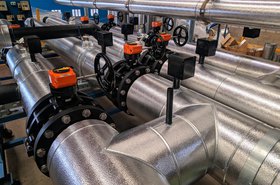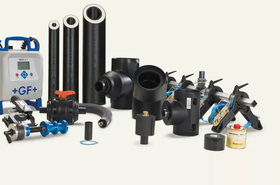Behind all the major advances from the dawn of the industrial age to the present day – the blast furnace, the internal combustion engine, microprocessors, etc – lay thousands upon thousands of small, incremental developments: in metals, other materials, fuels and so on.
It’s the same in the data center today. While the focus might be on, say, immersion cooling, data center cooling and the benefits of next-generation microprocessors, there are multiple developments helping to improve efficiency and sustainability that just don’t get the attention they deserve. One of those areas is piping and the benefits of using high-tech plastic piping over metal.
Of course, it can be hard to quantify the benefits of using a component made of one material over another, still less to put into words.
But that is all changing with the availability of tools like GF Piping System’s Data Center Portal. This free-to-use collection of online tools can put into numbers the benefits of using plastic piping over metal, in the kind-of way that won’t just persuade the CFO, but also the CEO, engineers and the executives responsible for delivering on corporate sustainability commitments.
Moreover, there are also tools available that can help engineers more used to working with metal piping make the shift, and can be used regardless of what design phase they are involved in, be it design, planning, or construction
One word: Plastics
But first, what about the sustainability ‘credentials’ of using plastic over metal?
While it might sound like a contradiction in terms, there are good environmental, as well as operational, reasons for adopting plastic for piping in data centers over copper, carbon steel or aluminium.
First, metals don’t exactly come without their own environmental costs in terms of mining, refining and manufacturing. Copper, for example, has to be extracted from oxide and sulfide ores that are typically between just 0.5 percent and two percent copper, and the refining process is complex, energy intensive, and involves multiple steps.
Steel is equally environmentally challenging, with steel production notoriously energy intensive and one of the biggest global producers of CO2 emissions.
The refining processes of all metals, of course, also generate multiple tons of toxic waste, both solid and gaseous, reflecting the use of noxious substances such as arsenic, mercury and sulfur (among others) used to extract the single-digit percentages of metal from the ore.
Plastic piping for data center cooling solutions, on the other hand, will be produced from either natural gas or oil, refined into ethane and propane, and then converted via a straightforward, high-heat process into materials like ethylene and propylene.
The plastic piping itself, of course, won’t be a carbon copy of its metal equivalent, according to Mark Bulmer, head of Data Centers Global Market Development, at GF Piping Systems.
“The dimensions of plastic pipe are slightly different to that of metal. The internal bore, for instance or internal dimensions of the piping will be slightly different in a plastic pipe,” says Bulmer.
Plastic piping also offers multiple advantages over metal piping: it is lightweight and easy to transport, it is longer lasting and more resistant to corrosion and, hence, helps protect equipment from the consequences of such degradation.
And, as a lighter material, it is also easier to install, says Bulmer. “Plastic piping is about one-third the weight of metal piping, so the amount of support required to hold that static load is different. If you design the support with metal piping in mind, then install plastic piping, it’ll be completely over-engineered and, therefore, a waste of money.”
Hence, when all the carbon and other environmental costs of both metal and plastic piping are added up and compared, plastic is overall the more environmentally friendly, more sustainable option, according to consultants at McKinsey. In a study, they examined the total greenhouse gas contributions of plastic piping against piping made from a range of other, conventional materials across a range of industries, including the data center sector.
The research found that plastic piping was not simply a little bit better, in environmental terms, but a whole lot better. PVC compared to ductile iron produced 35 percent lower greenhouse gas emissions, for example, while cross-linked polyethene (PEX) compared to copper produced 25 percent lower greenhouse gas emissions. And that’s just in terms of production.
But if the research wasn’t enough to convince you, GF Piping System’s Data Center Portal has a number of tools that can calculate total CO2 savings, while helping environmentally conscious designers and engineers to reliably make the transition from metal to plastic.
Carbon calculator
These include a CO2 Footprint Calculator [registration required] that can offer a precise number in terms of kilos of CO2 savings that can be achieved by adopting the appropriate plastic piping, compared to its metal equivalent.
This is especially useful in the construction phase of a data center when organizations will increasingly be expected to account for every gram of CO2 emissions embedded in a design.
“Our embedded carbon calculation tool will evaluate the savings you can achieve by using plastic pipe compared to metal pipe in terms of raw materials and embedded carbon in the product.
“The benefits are usually in the order of approximately 50 percent. So you can reduce an awful lot in terms of your CO2 embedded carbon footprint by using plastic pipes,” says Bulmer.
Of course, if an organization has been using carbon steel piping, there will still be understandable reluctance to shift to plastic piping, regardless of how good the results of the carbon calculator look. After all, when it comes to cooling infrastructure there’s all kinds of other considerations to bear in mind, such as pressure drop, dew point, expansion or contraction (depending on the temperature of the liquid) and so on.
But GF Piping System’s Portal has this covered, too, with its Cooling Calculation tool, which is also free to use [registration required]. For organizations that are looking towards heat reuse, this tool can convert heat loss or gain into a US dollar figure (as well as helping to make an even stronger case for migrating to plastic piping).
Allied to that is GF Piping System’s Advanced Engineering Calculations too, intended to guide both new and experienced users of plastic piping towards the piping that will reliably work for them, whatever the application.
This kind of transparency is invaluable, because although piping may only be a minor line item in terms of outlay, the potential costs caused by leaks can be off-the-scale. Forty percent of design errors result in stress cracks in piping, and these cracks, of course, can very quickly turn into damaging leaks at an average estimated cost of £100,000 per hour of downtime.
Tying all that together is GF Piping’s Digital Library of BIM-compatible CAD drawings, available in a range of formats.
Enabling designers to take accurate CAD drawings off-the-shelf both saves them time and ensures that errors are minimized. However, in the past, such architectural and engineering drawings represented information silos.
Building information modelling (BIM) not only helps bring together all the technical drawings and other critical data related to them, but also provides the mechanism by which they can be updated, too. In the process, the BIM files provide vital information for the running and maintenance of the data center, not just on opening day, but long into the future.
“BIM is a methodology enabling different companies to transfer and read technical building data easily to enable an accurate and up-to-date information flow,” says Bulmer. “And, later, for on-site management, the attributes of all the drawings will be similar, from one supplier to another.”
Moreover, it is increasingly becoming a regulatory requirement for major new facilities to both meet (and demonstrate that they are meeting) efficiency and sustainability requirements.
GF Piping System’s CAD library offers more than 25,000 drawings, together with all the technical data on pipes, fittings, measurement and control technology that any designer will ever need. It even has CAD drawings and other details covering manual and actuated valves, and they’re all compatible with Autodesk Revit and AutoCAD Plant3D, Aveva, and Intergraph.
And if that isn’t enough, GF Piping also offers a range of specialized engineering and design packages to support the conception and development process, with its dedicated engineering team even able to double check the design and calculations of a proposed piping system to ensure it all checks out.
After all, piping may seem small in terms of everything that goes into a modern data center, but the right choices can have an outsize influence on both reliability and sustainability – and GF Piping System’s free tools can prove it.
Register now on GF Piping’s customer portal and get access to the latest calculation, engineering and CAD tools.
More from GF Piping Systems
-

Sponsored Local manufacturing, on a global scale
How local capabilities on a global scale can help mitigate data center construction challenges
-

Sponsored Plastic fantastic: Significantly reducing data centers' energy bills
Why the inevitable shift to liquid cooling in data centers needn't be a pipe dream
-

Sustainable data center liquid cooling will need long-life plastic piping technology – GF Piping
Single-use plastics have been criticised for being environmentally harmful, but high-tech, long-lasting plastic technology in piping can enable energy efficient liquid cooling and much, much more

